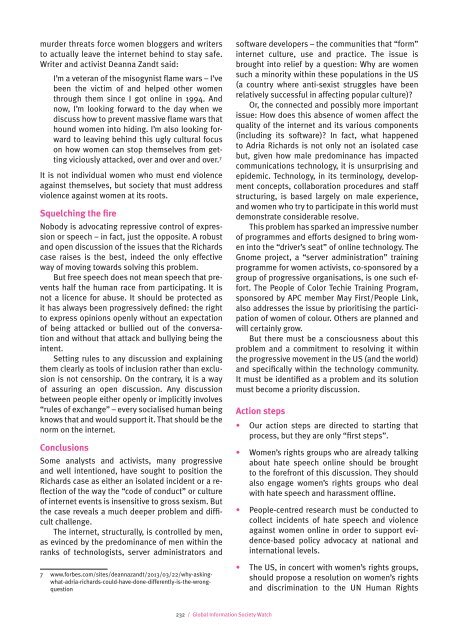gisw13_chapters
gisw13_chapters
gisw13_chapters
Create successful ePaper yourself
Turn your PDF publications into a flip-book with our unique Google optimized e-Paper software.
murder threats force women bloggers and writersto actually leave the internet behind to stay safe.Writer and activist Deanna Zandt said:I’m a veteran of the misogynist flame wars – I’vebeen the victim of and helped other womenthrough them since I got online in 1994. Andnow, I’m looking forward to the day when wediscuss how to prevent massive flame wars thathound women into hiding. I’m also looking forwardto leaving behind this ugly cultural focuson how women can stop themselves from gettingviciously attacked, over and over and over. 7It is not individual women who must end violenceagainst themselves, but society that must addressviolence against women at its roots.Squelching the fireNobody is advocating repressive control of expressionor speech – in fact, just the opposite. A robustand open discussion of the issues that the Richardscase raises is the best, indeed the only effectiveway of moving towards solving this problem.But free speech does not mean speech that preventshalf the human race from participating. It isnot a licence for abuse. It should be protected asit has always been progressively defined: the rightto express opinions openly without an expectationof being attacked or bullied out of the conversationand without that attack and bullying being theintent.Setting rules to any discussion and explainingthem clearly as tools of inclusion rather than exclusionis not censorship. On the contrary, it is a wayof assuring an open discussion. Any discussionbetween people either openly or implicitly involves“rules of exchange” – every socialised human beingknows that and would support it. That should be thenorm on the internet.ConclusionsSome analysts and activists, many progressiveand well intentioned, have sought to position theRichards case as either an isolated incident or a reflectionof the way the “code of conduct” or cultureof internet events is insensitive to gross sexism. Butthe case reveals a much deeper problem and difficultchallenge.The internet, structurally, is controlled by men,as evinced by the predominance of men within theranks of technologists, server administrators and7 www.forbes.com/sites/deannazandt/2013/03/22/why-askingwhat-adria-richards-could-have-done-differently-is-the-wrongquestionsoftware developers – the communities that “form”internet culture, use and practice. The issue isbrought into relief by a question: Why are womensuch a minority within these populations in the US(a country where anti-sexist struggles have beenrelatively successful in affecting popular culture)?Or, the connected and possibly more importantissue: How does this absence of women affect thequality of the internet and its various components(including its software)? In fact, what happenedto Adria Richards is not only not an isolated casebut, given how male predominance has impactedcommunications technology, it is unsurprising andepidemic. Technology, in its terminology, developmentconcepts, collaboration procedures and staffstructuring, is based largely on male experience,and women who try to participate in this world mustdemonstrate considerable resolve.This problem has sparked an impressive numberof programmes and efforts designed to bring womeninto the “driver’s seat” of online technology. TheGnome project, a “server administration” trainingprogramme for women activists, co-sponsored by agroup of progressive organisations, is one such effort.The People of Color Techie Training Program,sponsored by APC member May First/People Link,also addresses the issue by prioritising the participationof women of colour. Others are planned andwill certainly grow.But there must be a consciousness about thisproblem and a commitment to resolving it withinthe progressive movement in the US (and the world)and specifically within the technology community.It must be identified as a problem and its solutionmust become a priority discussion.Action steps• Our action steps are directed to starting thatprocess, but they are only “first steps”.• Women’s rights groups who are already talkingabout hate speech online should be broughtto the forefront of this discussion. They shouldalso engage women’s rights groups who dealwith hate speech and harassment offline.• People-centred research must be conducted tocollect incidents of hate speech and violenceagainst women online in order to support evidence-basedpolicy advocacy at national andinternational levels.• The US, in concert with women’s rights groups,should propose a resolution on women’s rightsand discrimination to the UN Human Rights232 / Global Information Society Watch


